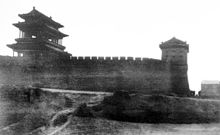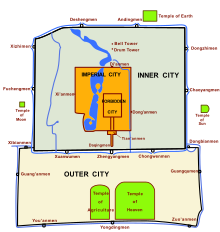Guang'anmen
This article relies largely or entirely on a single source. (August 2012) |
This article needs additional citations for verification. (August 2012) |
Template:Contains Chinese text 39°53′22″N 116°21′00″E / 39.889423°N 116.349978°E


Guang'anmen (Chinese: 广安门; pinyin: Guáng ān mén), also known as Guangningmen (广宁门), Zhangyimen (张仪门 or 彰仪门) was a city gate of old Beijing, constructed during the reign of Jiajing Emperor (1521–1567), Ming Dynasty. This gate was part of Beijing's city wall, situated south-west of the city center and faced east. Guang'anmen served as a main entrance to Beijing. Yanjingji (燕京记), records written by the famous Qing historian Gusen (顾森), described the gate as follows: Of the seven outer city gates, the one facing east is called Guangningmen. 15km to the west of the gate is Lugou bridge, if you cross the bridge and continue 20km, you will find Liangxiang county. The gate is a strategic passage for ground traffic from Southern provinces and is of vital importance (外城七门,面向西者广宁门,西行三十里卢沟桥,过桥四十里即是良乡县,为各省陆路进京之咽喉).
The gate was torn down for construction of Beijing's second ringroad, which led to the demolition of most of Beijing city fortifications. The original two-story tower with double eaves was 17.6m tall, 13.8m long and 6m wide. The tower and the wall combined had a height of 26m.
History
Guang'anmen was known as Guangningmen in the Ming and early Qing Dynasty. It was renamed by Daoguang Emperor, whose private name is Minning and the shares the character Ning (宁) with Guangningmen, as the ancient Chinese tradition naming taboo discourages the use of given names of the emperor.
The Guanganmen Incident of 26 July 1937 occurred at Guang'anmen gate and was part of the Second Sino-Japanese War. This incidence ultimately resulted in the retreat of Chinese armies to southern provinces, the fall of Beijing and Tianjing, and the Japanese occupation of the entire North China Plain later that year.[1]
Neighbourhood
Guang'anmen is now the name of a Beijing neighbourhood in Xicheng District. After the completion of Guang'an Avenue (广安大街), one of the main traffic arteries of modern Beijing, the area has become an important business district. It is also home to a few prestigious education institutes, including Central Conservatory of Music, Beijing Primary School(北京小学) and Beijing No.14 Middle School(北京十四中). Public transportation is convenient as Line 7 of the Beijing Subway passes underneath Guang'anmen Street. The neighbourhood is also accessible with public bus lines 5, 6, 19, 38, 40, 42, 46, 49, 57, 76, 78, 80, 84, 109, 122, 340, 381, 390, 410, 456, 477, 676, 691, 697, 717, 741, 844, 937, 特5, 特12, 夜7, 夜20, 夜22, and 运通102.
See also
References
- ^ Press Corps of the War Ministry of Japan 1937 p.4-6
